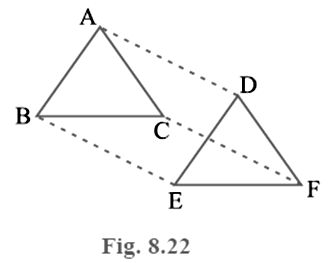In Δ ABC and Δ DEF, AB = DE, AB || DE, BC = EF and BC || EF. Vertices A, B and C are joined to vertices D, E and F respectively (see Fig. 8.22). Show that
(i) Quadrilateral ABED is a parallelogram
(ii) Quadrilateral BEFC is a parallelogram
(iii) AD || CF and AD = CF
(iv) Quadrilateral ACFD is a parallelogram
(v) AC = DF
(vi) Δ ABC ≅Δ DEF.

(i) Given that: AB = DE and
AB || DE
If two opposite sides of a quadrilateral are equal and parallel to each other, then it will be a parallelogram.
Therefore, quadrilateral ABED is a parallelogram
(ii) Again,
BC = EF and BC || EF
Therefore, quadrilateral BCEF is a parallelogram
(iii) As we had observed that ABED and BEFC are parallelograms
Therefore,
AD = BE and AD || BE
(Opposite sides of a parallelogram are equal and parallel)
And,
BE = CF and BE || CF
(Opposite sides of a parallelogram are equal and parallel)
AD = CF and AD || CF
(iv) As we had observed that one pair of opposite sides (AD and CF) of quadrilateral
ACFD are equal and parallel to each other, therefore, it is a parallelogram
(v) As ACFD is a parallelogram, therefore, the pair of opposite sides will be equal and parallel to each other
AC || DF and AC = DF
(vi) ΔABC and ΔDEF,
AB = DE (Given)
BC = EF (Given)
AC = DF (ACFD is a parallelogram)
ΔABC ![]() ΔDEF (By SSS congruence rule)
ΔDEF (By SSS congruence rule)